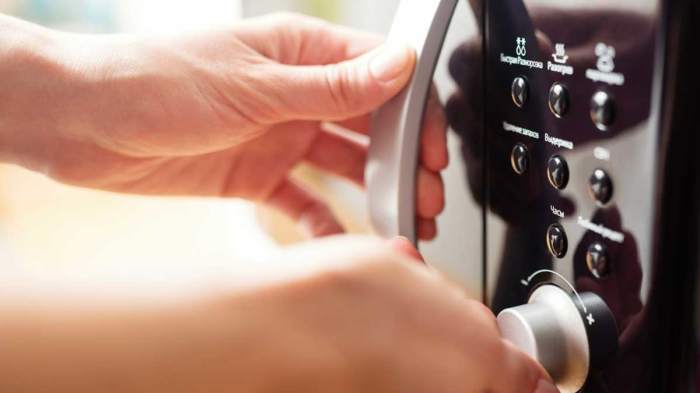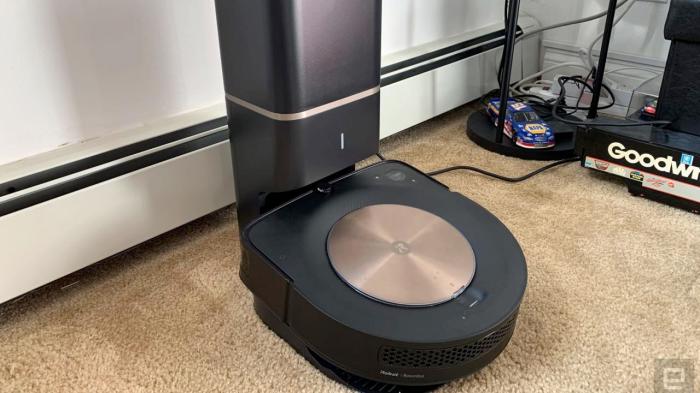Microwave Oven Buying Guide For Beginners
Microwave Oven Buying Guide for Beginners: This comprehensive guide will equip you with the knowledge needed to navigate the world of microwaves. From understanding the various types to choosing the right capacity and features, we’ll explore everything you need to know to make an informed purchase decision.
This guide simplifies the process of selecting the perfect microwave for your needs, considering factors like capacity, power levels, features, safety, budget, reviews, and ultimately, the best model for your kitchen and lifestyle.
Introduction to Microwave Ovens
Microwave ovens are a convenient and efficient way to heat, cook, and reheat food quickly. They utilize electromagnetic waves to excite water molecules in food, generating heat and thus cooking the food. This technology allows for faster cooking times compared to conventional ovens, saving valuable time in the kitchen.Microwave ovens come in various types, each designed for specific needs and kitchen layouts.
Understanding the differences between these types is crucial for making an informed purchase decision. Choosing the right microwave depends on factors like available counter space, desired features, and the overall aesthetic of your kitchen.
Types of Microwave Ovens
Microwave ovens are categorized into countertop, built-in, and over-the-range models. Each type has its own advantages and disadvantages, making the selection process dependent on individual preferences and kitchen setup.
Countertop Microwaves
Countertop microwaves are the most common type, typically freestanding appliances that sit directly on a countertop. They are generally compact and affordable, fitting well into smaller kitchens. Their simple design makes them straightforward to use, a benefit for beginners. Their compact size often translates into lower power ratings and reduced cooking capacity compared to other types.
Built-in Microwaves
Built-in microwaves are designed to seamlessly integrate into existing cabinetry. Their sleek, flush design enhances the overall aesthetic of the kitchen, creating a cohesive look. Built-in microwaves often offer more advanced features, such as sensor cooking, compared to their countertop counterparts. Their installation requires careful planning and professional assistance, often with specialized electrical and cabinetry considerations.
Over-the-Range Microwaves
Over-the-range microwaves are designed to be installed above a stovetop. They combine the functions of a microwave oven with a range hood, effectively managing cooking fumes. This type is a space-saving option, especially in kitchens with limited counter space. They typically offer more powerful cooking capabilities than countertop models due to their larger size and higher power ratings.
However, they often come with a higher price tag than countertop or built-in models.
Comparison of Microwave Oven Types
| Feature | Countertop | Built-in | Over-the-Range |
|---|---|---|---|
| Size | Compact, typically smaller footprint | Similar size to countertop, but flush-mounted | Larger, often incorporating a range hood |
| Price | Generally the most affordable | Mid-range pricing, often more expensive than countertop | Typically the most expensive due to added features |
| Features | Basic features, potentially with simple sensor cooking | More advanced features, including sensor cooking, convection, and variable power levels | Combines microwave functionality with a range hood, potentially including features like air fry |
| Installation Requirements | Simple, direct placement on countertop | Requires careful planning, potentially professional installation to match existing cabinetry | Installation above a stovetop, often with specialized vent and exhaust systems |
Choosing the Right Capacity
Choosing the right microwave capacity is crucial for maximizing your appliance’s usefulness and ensuring it meets your specific needs. A microwave that’s too small can be frustrating, while one that’s excessively large might be unnecessary and take up valuable counter space. Understanding your household’s typical meal sizes and frequency will guide you towards an optimal capacity.A microwave’s capacity, typically measured in liters or cubic feet, dictates the size of food items that can be cooked comfortably.
A well-chosen capacity ensures efficient and convenient meal preparation without compromising on quality. Different lifestyles and family sizes necessitate varying capacities. A single individual may not require the same capacity as a large family or a household that frequently cooks for guests.
Factors Influencing Capacity Needs
Understanding the factors that influence your capacity needs is essential for selecting the appropriate size. Factors like meal frequency, family size, and typical dish sizes play a significant role. For example, a household with a large family that regularly cooks for a large number of people will require a larger capacity microwave. Similarly, those who cook frequently and prepare larger dishes will benefit from a larger capacity compared to individuals or couples who cook only occasionally.
Typical Capacity Requirements for Various Households
The following table offers a guideline for selecting the appropriate microwave capacity based on typical family sizes and meal frequency. These estimations provide a useful benchmark for determining the capacity needed.
| Family Size | Typical Meal Frequency | Recommended Capacity (Liters) | Suitability |
|---|---|---|---|
| 1-2 people | Occasional cooking | 1.0 – 1.5 | Suitable for reheating leftovers, small meals, and quick cooking tasks. |
| 1-2 people | Frequent cooking | 1.5 – 2.0 | Suitable for reheating, quick cooking, and preparing larger single-serving meals. |
| 3-4 people | Occasional cooking | 2.0 – 2.5 | Suitable for reheating and cooking for small groups. |
| 3-4 people | Frequent cooking | 2.5 – 3.0 | Suitable for reheating, cooking multiple dishes, and accommodating larger portion sizes. |
| 5+ people | Occasional cooking | 3.0+ | Suitable for reheating and cooking larger meals for larger groups. |
| 5+ people | Frequent cooking | 3.5+ | Suitable for cooking multiple dishes, larger family meals, and large batches of food. |
Capacity Options and Considerations
Different microwave capacities offer varying degrees of convenience and utility. A smaller capacity is suitable for individuals or couples with limited cooking needs, while larger capacities are better suited for families with frequent cooking needs or those who often cook for guests. Consider your lifestyle and cooking habits when selecting a microwave capacity. Choosing a capacity that’s too small can lead to frequent reheating or cooking in batches, potentially impacting cooking efficiency and convenience.
Conversely, a larger capacity than needed may lead to wasted space and a higher price point.
Understanding Power Levels and Features: Microwave Oven Buying Guide For Beginners
Choosing a microwave oven goes beyond just capacity; understanding its power levels and features significantly impacts your cooking experience. Different power settings allow for precise control over cooking times and temperatures, while features like sensor cooking and defrosting can save time and effort. This section delves into the practical applications of power levels and common features, helping you make an informed decision.
Power Levels and Their Impact
Microwave ovens typically offer various power levels, often ranging from 10% to 100% of their maximum power. These power levels dictate the intensity of the microwaves emitted, affecting cooking times and results. A lower power setting is ideal for delicate foods, preventing them from becoming overcooked or dry. Conversely, higher power settings are suited for tasks requiring faster heating or browning.
Understanding how different power levels impact cooking is crucial for achieving optimal results. For example, melting chocolate on a high setting could result in burning it, while a low setting would allow for a more controlled and even melting process.
Sensor Cooking
Sensor cooking automatically adjusts cooking times and power levels based on the food’s moisture content and density. This feature eliminates the need for precise measurements, making the cooking process simpler and more convenient for beginners. The sensor detects the food’s temperature and adjusts accordingly to ensure even heating and optimal results. This feature is particularly useful for items with varying densities and water content, like soups or stews, or reheating food.
Defrosting
Defrosting features automatically adjust power levels and times based on the food’s weight. This significantly simplifies the defrosting process, preventing the food from becoming excessively hot or dry. Many modern microwaves offer both automatic defrosting and manual defrosting options. This allows for tailored control over the defrosting process. For example, defrosting a chicken breast might take less time with an automatic defrost feature, ensuring the food is safely defrosted and ready to cook without overcooking.
Automatic Settings
Many microwave ovens offer automatic settings for common cooking tasks, such as popcorn, reheating, or cooking specific food types. These pre-programmed settings streamline the cooking process and help beginners achieve consistent results. Automatic settings often include optimized power levels and times based on the selected food type, which helps maintain food quality and consistency. For example, using the automatic popcorn setting ensures that the popcorn is cooked evenly and to the desired level of crispness.
Table of Power Levels and Features
| Cooking Task | Power Level | Feature | Benefits |
|---|---|---|---|
| Melting chocolate | Low (10-30%) | Manual control | Prevents burning, allows for even melting |
| Reheating soup | Medium (50-70%) | Sensor cooking | Ensures even heating, reduces overcooking |
| Defrosting fish | Low (10-20%) | Defrost setting | Prevents dryness, allows for a more controlled defrosting |
| Cooking popcorn | High (100%) | Automatic popcorn | Ensures consistent crispness, optimized cooking time |
Important Safety Considerations
Proper use of a microwave oven is crucial to prevent accidents and ensure a safe cooking experience. Understanding potential hazards and adhering to safety precautions is vital for minimizing risks. This section details essential safety measures to take when operating a microwave oven.Microwave ovens, while convenient, can present safety risks if not handled carefully. Ignoring safety guidelines can lead to burns, equipment damage, and even more serious incidents.
The following sections will elaborate on important safety precautions and features designed to mitigate these hazards.
Microwave Oven Safety Precautions
Safe operation of a microwave oven involves adhering to specific precautions. These steps minimize the risk of injuries and equipment damage. Failure to follow these guidelines can lead to potential hazards.
- Always supervise children when using a microwave oven. Children lack the awareness and judgment necessary to handle microwave ovens safely. Constant adult supervision is recommended to prevent accidental burns or injuries.
- Inspect the appliance regularly for any visible damage to the door, seals, or heating components. Damaged parts can compromise the safety features of the microwave oven, potentially leading to overheating or electric shock hazards. Regular checks ensure the microwave oven remains in optimal operating condition.
- Never operate a microwave oven without food inside. This can cause the magnetron to overheat, potentially damaging the oven and posing a fire hazard. Placing food inside the oven is crucial for safe operation.
- Use appropriate cookware designed for microwave use. Certain materials can react negatively to microwave energy, leading to sparks or damage. Using compatible cookware is essential for preventing these issues.
- Do not operate a microwave oven with a damaged cord or plug. A damaged cord can pose a significant electric shock hazard. Replacing the cord immediately is essential for safety.
- Avoid using metal objects inside the microwave oven. Metal can cause sparks and damage the oven’s components. Using metal utensils or containers can lead to significant risks.
- Do not repair the microwave oven yourself unless you are a qualified technician. Attempting repairs without proper knowledge can lead to electrical hazards or further damage. Professionals should address any repairs.
Common Safety Features
Modern microwave ovens often incorporate safety features to minimize risks. These features help prevent accidents and maintain safe operation.
- Automatic shut-off mechanisms: These features automatically turn off the microwave if it detects unusual conditions, such as an obstruction or overheating. This feature prevents potential damage and hazards.
- Interlocks and safety switches: These mechanisms prevent the microwave from operating unless the door is securely closed. This critical safety measure ensures the microwave oven cannot operate with an open door.
- Overheating protection systems: These features prevent the microwave from overheating, protecting the components and minimizing the risk of fire. Overheating protection prevents potential damage and hazards.
- Child safety locks: These locks prevent children from accidentally turning on the microwave. Child safety locks provide additional protection against unauthorized use.
Safety Tips for Microwave Oven Use
These tips can help prevent accidents and ensure safe and efficient use of your microwave oven.
- Always follow the manufacturer’s instructions carefully for safe operation and maintenance. The manufacturer’s guidelines are crucial for safe and efficient use.
- Do not force items into the microwave. Properly sized containers prevent spills and damage. This practice prevents damage to the appliance and prevents spills.
- Use a microwave-safe container for all food items. Avoid using containers that can melt or react with the microwave energy. Using appropriate containers is vital for preventing damage and hazards.
- Inspect the turntable and the interior for any debris or obstructions. Regular checks ensure smooth operation. Clearing obstructions ensures smooth operation.
- Report any malfunction or unusual noise immediately to a qualified technician. Ignoring these signs can lead to serious damage. Seeking professional help is essential for maintaining the appliance’s integrity.
Budget and Price Range

Choosing a microwave oven often involves balancing desired features with your budget. Understanding the relationship between price and included features is crucial to making an informed decision. Different price points offer varying capacities, power levels, and additional functionalities, which we will explore in more detail.
Price Range and Corresponding Features
Microwave ovens are available in a spectrum of price ranges, each reflecting a different set of features and capacities. The price often correlates with the sophistication of the appliance. Budget-friendly models typically prioritize basic functions, while higher-end models boast advanced features and higher capacities. A thoughtful consideration of your needs and budget will guide your selection process.
Budget-Friendly Microwaves (Under $100)
These models are often compact and simple, focusing on the essential cooking functions. Features may be limited, but they typically provide adequate performance for basic reheating and cooking needs. They may lack advanced features like sensor cooking or multiple power levels, focusing primarily on straightforward operation. An example might be a basic countertop model with a single turntable and a few power settings.
The pros include affordability and ease of use. Cons might include limited capacity and features.
Mid-Range Microwaves ($100-$250)
Mid-range models typically offer more features than budget-friendly options. They may include features such as multiple power levels, a larger capacity, and potentially a turntable or other helpful features. These microwaves are often a good compromise between price and performance. For instance, a mid-range model could have a larger interior capacity, a turntable, and more power settings.
The pros are a balance of features and price, offering a good value for money. The cons could include less advanced functionalities compared to higher-end models.
Higher-End Microwaves (Over $250)
Higher-end microwaves are designed for those seeking advanced features and larger capacities. These models often include features like sensor cooking, convection cooking, defrosting features, and larger capacities. They often come with sophisticated controls and display systems. For example, a higher-end model might offer convection cooking, a large capacity suitable for family meals, and a touch screen interface.
Pros include superior performance, advanced features, and larger capacity, which are often more energy-efficient. Cons could be a higher price point.
Comparative Table of Price Ranges
| Price Range | Features | Capacity (approx.) | Example |
|---|---|---|---|
| Under $100 | Basic cooking functions, single turntable | 0.7 – 1.0 cu ft | Example: Model X from Brand Y |
| $100-$250 | Multiple power levels, turntable, larger capacity | 1.0 – 1.6 cu ft | Example: Model Z from Brand A |
| Over $250 | Sensor cooking, convection, larger capacity, advanced controls | 1.6+ cu ft | Example: Model AA from Brand B |
Evaluating User Reviews and Ratings
Reading user reviews and ratings is a crucial step in the microwave oven buying process. These insights provide valuable perspectives from actual users, offering a glimpse into the real-world performance and experience with different models. By understanding common issues and positive aspects reported by previous buyers, you can make a more informed decision and avoid potential pitfalls.User reviews offer a direct window into the practical application of microwave ovens.
They transcend marketing claims and highlight features that truly matter to consumers. This allows you to assess how well the oven performs in everyday use, addressing potential problems like uneven heating, inconsistent power levels, or noise levels. Positive feedback can help you identify models that consistently meet user expectations.
Significance of User Reviews
User reviews are invaluable because they provide real-world feedback on the performance and functionality of a microwave oven. They offer insights into the practical experience of using the oven, beyond what is highlighted in marketing materials. By reading reviews, you can learn about potential issues, strengths, and weaknesses of different models, making your purchase decision more informed and less reliant on marketing hype.
Evaluating Credibility and Helpfulness, Microwave Oven Buying Guide for Beginners
To effectively utilize user reviews, it’s essential to evaluate their credibility and helpfulness. Look for reviews with specific details and well-reasoned opinions. Reviews that simply state “good” or “bad” without explaining why are less helpful. Consider the user’s experience level and how their usage patterns might affect their review.A helpful review will describe specific issues, like inconsistent power levels or difficulty using the controls.
It might also detail positive aspects, such as the oven’s quiet operation or its ability to cook food quickly and evenly. The number of helpful votes or responses to the review can also indicate its reliability. Consider reviews with a large number of positive ratings or comments.
Identifying Common Issues and Positive Aspects
User reviews can highlight common issues across different models. For example, some models might be prone to uneven heating, leading to undercooked or overcooked food. Other models might struggle with defrosting, or have noisy operation. Conversely, reviews might praise the oven’s speed, quietness, or intuitive controls.Positive aspects highlighted by numerous users could include the oven’s sleek design, its large capacity, or the ease of cleaning.
Understanding these recurring themes allows you to identify models that consistently address common user concerns or excel in specific areas.
Comparing User Ratings and Reviews
| Microwave Oven Model | Average User Rating | Common Issues (based on reviews) | Positive Aspects (based on reviews) |
|---|---|---|---|
| Model A | 4.5 out of 5 | Some users reported inconsistent heating, particularly on higher power levels. | Many users praised the oven’s large capacity and quick cooking times. |
| Model B | 4.2 out of 5 | A few users noted difficulty with the controls. | Positive comments about the quiet operation and ease of cleaning. |
| Model C | 4.8 out of 5 | No significant negative issues reported in user reviews. | High praise for even heating, speed, and user-friendly controls. |
This table provides a basic comparison. You should always research multiple sources and consider the specifics of your needs when making a final decision.
Selecting a Microwave Oven Model
Choosing the right microwave model involves careful consideration of your specific needs and preferences. Factors like budget, desired features, and available space significantly influence your selection. This section will guide you through evaluating various models, highlighting key distinctions, and helping you narrow down your choices.Once you’ve established your budget, capacity requirements, and desired features, it’s time to explore specific models.
Comparing different models allows you to appreciate the unique selling points of each and make an informed decision. This section provides a structured approach to evaluating various models, taking into account key features and potential drawbacks.
Specific Models Based on Budget, Features, and Capacity
A variety of microwave models cater to different budgets, feature sets, and capacity needs. Consider models with notable features like sensor cooking, inverter technology, or extra-large capacity. These factors play a crucial role in selecting the right appliance for your needs and preferences.
Comparing and Contrasting Different Microwave Models
Evaluating various models involves comparing their features, functionality, and performance. Some models may excel in specific areas, such as sensor cooking or precise power control, while others might prioritize a larger capacity or a more modern aesthetic. Thorough comparison is essential to determine which model best suits your requirements.
Unique Selling Points of Microwave Models
Different microwave models possess distinct selling points. Some may boast advanced features like inverter technology for precise temperature control and faster cooking. Others might emphasize a sleek design, spacious interior, or simple, intuitive controls. These unique features contribute to the overall appeal and functionality of each model.
Factors to Consider When Comparing Models
When comparing models, several factors are critical. These include:
- Capacity: Consider the amount of food you typically cook and the size of your dishes.
- Power Levels: Different power levels affect cooking times and outcomes. Models with more precise power adjustments provide more control.
- Features: Sensor cooking, inverter technology, and defrost options can enhance usability and cooking precision.
- Ease of Use: Intuitive controls, clear displays, and simple operation are vital for convenient use.
- Warranty: A longer warranty provides peace of mind and indicates the manufacturer’s confidence in their product’s reliability.
- Design and Aesthetics: Consider the overall design and fit of the microwave within your kitchen.
Popular Microwave Oven Models
The following table provides a snapshot of popular microwave models categorized by features, price, and capacity. These examples showcase the diverse range of options available.
| Model | Features | Price Range (Estimated) | Capacity (cu. ft.) |
|---|---|---|---|
| Whirlpool Model 1 | Sensor cooking, inverter technology | $200-$300 | 1.6 |
| Samsung Model 2 | Large capacity, sleek design | $300-$400 | 2.2 |
| LG Model 3 | Precise power control, advanced defrost options | $250-$350 | 1.7 |
| GE Model 4 | Simple controls, affordable price | $150-$250 | 1.4 |
Note: Prices are estimated and may vary depending on retailer and promotions. Capacity figures are approximate.
Installation and Maintenance
Proper installation and maintenance are crucial for ensuring the safe and efficient operation of your microwave oven. A correctly installed unit will function optimally, and neglecting maintenance can lead to potential hazards or premature component failure. Following the manufacturer’s instructions and performing routine checks will help you maximize the lifespan and performance of your microwave.
Installation Procedures
Correct installation is vital for safety and performance. Improper installation can lead to electrical hazards, damage to the appliance, and potentially affect the microwave’s performance. Ensure that you consult the manufacturer’s manual before starting any installation procedures.
- Location Selection: Choose a location that provides adequate ventilation, is away from heat sources (such as ovens or stoves), and has a stable, level surface. Do not install the microwave near flammable materials.
- Electrical Connections: Verify the electrical outlet’s compatibility with the microwave’s specifications. Ensure the outlet is properly grounded and capable of handling the microwave’s power requirements. Never overload the circuit with other appliances. A qualified electrician should be consulted if you are uncertain about electrical work.
- Placement and Leveling: Place the microwave on a level surface to ensure proper operation and prevent uneven heating. Use shims or levelers if necessary to achieve a stable position.
- Connecting the Power Cord: Carefully plug the microwave into the designated outlet. Ensure the power cord is not stretched or damaged in any way. Inspect the cord for any signs of wear or damage before connecting to the power source. Never use an extension cord unless specified by the manufacturer.
- Confirmation of Operation: After completing the installation, test the microwave to verify proper operation. Ensure all functions, including power levels and safety features, work as expected. Note any issues immediately for resolution.
Common Installation Issues and Solutions
Potential issues during installation can arise, and recognizing these and their solutions is crucial for successful installation.
- Uneven Heating: If the microwave oven heats unevenly, it may be due to an unstable base. Ensure the microwave is properly leveled and the surface is stable. Consider using shims or leveling feet to adjust the position.
- Electrical Problems: If the microwave doesn’t turn on, check the electrical outlet, the power cord, and the circuit breaker. If the problem persists, contact a qualified electrician to diagnose the issue.
- Incorrect Placement: The microwave should be installed away from heat sources, to prevent potential damage or hazards. If the microwave is too close to a stove or oven, it could affect the performance of either appliance.
- Ventilation Issues: Ensure adequate ventilation around the microwave. Improper ventilation can lead to overheating. Check that the microwave is not positioned near objects that may restrict air circulation.
Maintenance Procedures
Regular maintenance is vital to prolong the life of your microwave oven and prevent potential issues.
- Cleaning the Interior: Regularly clean the microwave’s interior with a damp cloth or sponge. Avoid harsh chemicals. Use a mild cleaning solution for tough stains.
- Cleaning the Exterior: Wipe down the exterior with a damp cloth and mild cleaner. Avoid using abrasive cleaners or scouring pads.
- Checking the Door Seal: Inspect the door seal regularly for any signs of damage or wear. A damaged seal can lead to microwave leakage. If damaged, replace it.
- Cleaning the turntable (if applicable): Remove the turntable and clean it thoroughly. Follow the manufacturer’s instructions. Remove any food particles or debris.
Troubleshooting
Troubleshooting common problems will save you time and money.
- Microwave not working: Check the power cord, circuit breaker, and fuse box. If the issue persists, consult the manufacturer’s manual or contact customer support.
- Uneven heating: Ensure the microwave is level. Clean the interior and check the turntable. If the issue persists, consult the manufacturer’s manual or contact customer support.
- Sparks or odors: Inspect the inside of the microwave for any unusual objects or food particles. If the issue persists, consult the manufacturer’s manual or contact customer support.
Illustrative Examples of Microwave Cooking
Microwave ovens offer a convenient and efficient way to prepare various dishes, from reheating leftovers to creating complete meals. Their versatility allows for quick and easy cooking, making them a valuable asset in busy kitchens. Understanding the various cooking methods and techniques can unlock the full potential of your microwave.
Reheating Leftovers
Proper reheating ensures food safety and maintains optimal taste. Using the defrost or reheat settings, or simply adjusting the power level, can significantly impact the outcome. Always check the temperature to ensure food reaches a safe internal temperature.
- Step-by-Step Instructions for Reheating a Pizza:
Place the pizza on a microwave-safe plate. Select the “reheat” or “defrost” function, if available, or use a lower power level (e.g., 50%) if no specific setting exists. Cook in 30-second intervals, monitoring the temperature and stirring gently halfway through. Continue until the pizza is heated through and reaches the desired temperature. For best results, cover the plate with a microwave-safe lid. - Tips for Preventing Overheating: Keep an eye on the food during reheating to avoid overcooking or drying it out. Using smaller portions or covering the food will also help maintain moisture and prevent uneven heating.
Cooking Vegetables
Microwaves can be used to quickly and efficiently cook vegetables, preserving their nutrients. Different vegetables have varying cooking times, so understanding these differences is key.
- Cooking Broccoli Florets: Place broccoli florets in a microwave-safe bowl. Add a splash of water (about 1 tablespoon) to prevent drying. Cover with a microwave-safe lid. Cook on high for 2-3 minutes, stirring halfway through. Adjust cooking time based on desired doneness.
- Important Considerations: Choose vegetables that cook well in the microwave, and consider adding a small amount of liquid to prevent them from becoming too dry.
Defrosting Food
Defrosting food safely and efficiently is crucial for preventing bacterial growth. The defrost setting, or a lower power setting, is best suited for this task.
- Defrosting Chicken Breast: Place the chicken breast on a microwave-safe plate. Use the defrost function, if available. If not, use a lower power setting (e.g., 20-30%). Cook in 1-minute intervals, monitoring the food. Ensure the chicken is thoroughly defrosted and reaches a safe internal temperature.
- Safety Precautions: Never defrost food at room temperature, as this can lead to bacterial growth. Always ensure the food reaches a safe internal temperature before consumption.
Steaming Food
Steaming food in a microwave can retain nutrients and moisture. This method is suitable for various vegetables and fish.
- Steaming Asparagus: Place asparagus spears in a microwave-safe bowl. Add a small amount of water (about 1-2 tablespoons). Cover with a microwave-safe lid. Cook on high for 2-3 minutes, or until tender-crisp. Adjust cooking time as needed.
- Tips for Optimal Results: Use a microwave-safe steamer basket to ensure even steaming. Add a little water to the bowl to maintain moisture and prevent burning.
Cooking a Simple Meal (e.g., Egg and Cheese Omelette)
This method showcases the ability of microwave ovens to prepare a quick and easy meal.
- Ingredients: 1 egg, 1 tablespoon of milk, salt, pepper, and cheese. Microwave-safe bowl and spatula.
- Instructions: Beat the egg and milk in a bowl, and season with salt and pepper. Pour into the microwave-safe bowl. Microwave on high for 1-2 minutes, or until the egg is set. Sprinkle cheese on top and microwave for another 30 seconds, or until the cheese is melted.
Closing Notes
In conclusion, this guide has provided a thorough overview of microwave ovens, from their basic functions to advanced features and safety considerations. By carefully considering capacity, power, features, budget, reviews, and installation, you’ll be well-equipped to choose the ideal microwave oven for your needs. Remember to prioritize safety and consider your specific cooking habits when making your final decision.
Frequently Asked Questions
What are the common safety features in modern microwave ovens?
Modern microwaves often include features like automatic shut-off, child safety locks, and turntable safety mechanisms. Always refer to the manufacturer’s instructions for specific safety features on your chosen model.
How can I determine the appropriate microwave capacity for my household?
Consider the size of your family and the frequency of meal preparation. A larger capacity is beneficial for larger families or those preparing meals frequently. Smaller capacities are sufficient for smaller households or those who primarily reheat food.
What are the differences between countertop, built-in, and over-the-range microwaves?
Countertop microwaves are the most common and affordable. Built-in microwaves are integrated into cabinetry for a sleek aesthetic, while over-the-range microwaves are designed to be installed above a stovetop, often including ventilation features.





